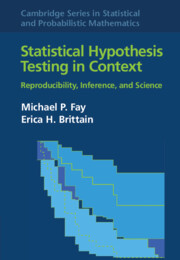Book contents
- Frontmatter
- Contents
- Preface
- 1 Introduction
- 2 Theory of Tests, p-Values, and Confidence Intervals
- 3 From Scientific Theory to Statistical Hypothesis Test
- 4 One-Sample Studies with Binary Responses
- 5 One-Sample Studies with Ordinal or Numeric Responses
- 6 Paired Data
- 7 Two-Sample Studies with Binary Responses
- 8 Assumptions and Hypothesis Tests
- 9 Two-Sample Studies with Ordinal or Numeric Responses
- 10 General Methods for Frequentist Inferences
- 11 k-Sample Studies and Trend Tests
- 12 Clustering and Stratification
- 13 Multiplicity in Testing
- 14 Testing from Models
- 15 Causality
- 16 Censoring
- 17 Missing Data
- 18 Group Sequential and Related Adaptive Methods
- 19 Testing Fit, Equivalence, and Noninferiority
- 20 Power and Sample Size
- 21 Bayesian Hypothesis Testing
- References
- Notation Index
- Concept Index
21 - Bayesian Hypothesis Testing
Published online by Cambridge University Press: 17 April 2022
- Frontmatter
- Contents
- Preface
- 1 Introduction
- 2 Theory of Tests, p-Values, and Confidence Intervals
- 3 From Scientific Theory to Statistical Hypothesis Test
- 4 One-Sample Studies with Binary Responses
- 5 One-Sample Studies with Ordinal or Numeric Responses
- 6 Paired Data
- 7 Two-Sample Studies with Binary Responses
- 8 Assumptions and Hypothesis Tests
- 9 Two-Sample Studies with Ordinal or Numeric Responses
- 10 General Methods for Frequentist Inferences
- 11 k-Sample Studies and Trend Tests
- 12 Clustering and Stratification
- 13 Multiplicity in Testing
- 14 Testing from Models
- 15 Causality
- 16 Censoring
- 17 Missing Data
- 18 Group Sequential and Related Adaptive Methods
- 19 Testing Fit, Equivalence, and Noninferiority
- 20 Power and Sample Size
- 21 Bayesian Hypothesis Testing
- References
- Notation Index
- Concept Index
Summary
This chapter gives a brief overview of Bayesian hypothesis testing. We first describe a standard Bayesian analysis of a single binomial response, going through the prior distribution choice and explaining how the posterior is calculated. We then discuss Bayesian hypothesis testing using the Bayes factor, a measure of how much the posterior odds of believing in one hypothesis changes from the prior odds. We show, using a binomial example, how the Bayes factor may be highly dependent on the prior distribution, even with extremely large sample sizes. We next discuss Bayes hypothesis testing using decision theory, reviewing the intrinsic discrepancy of Bernardo, as well as the loss functions proposed by Freedman. Freedman’s loss functions allow the posterior belief in the null hypothesis to equal the p-value. We next discuss well-calibrated null preferences priors, which applied to parameters from the natural exponential family (binomial, negative binomial, Poisson, normal), also give the posterior belief in the null hypothesis equal to valid one-sided p-values, and give credible intervals equal to valid confidence intervals.
- Type
- Chapter
- Information
- Statistical Hypothesis Testing in ContextReproducibility, Inference, and Science, pp. 389 - 403Publisher: Cambridge University PressPrint publication year: 2022



